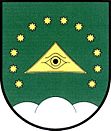Svébohov
| Svébohov | ||||
|---|---|---|---|---|
|
||||
| Basic data | ||||
| State : |
|
|||
| Region : | Olomoucký kraj | |||
| District : | Šumperk | |||
| Area : | 614 ha | |||
| Geographic location : | 49 ° 55 ' N , 16 ° 50' E | |||
| Height: | 417 m nm | |||
| Residents : | 418 (Jan. 1, 2019) | |||
| Postal code : | 789 01 | |||
| License plate : | M. | |||
| traffic | ||||
| Street: | Štíty - Rovensko | |||
| structure | ||||
| Status: | local community | |||
| Districts: | 1 | |||
| administration | ||||
| Mayor : | Petr Chamlar (as of 2009) | |||
| Address: | Svébohov 64 789 01 Zábřeh |
|||
| Municipality number: | 541125 | |||
| Website : | svebohov.zabrezsko.cz | |||
Svébohov (German Schwillbogen , also Schwilbogen ) is a municipality in the Czech Republic . It is located five kilometers northwest of Zábřeh and belongs to the Okres Šumperk .
geography
Svébohov is located in the Drozdovská vrchovina (Drosenauer Uplands) to the Müglitzer Furche (Mohelnická brázda) on the Svébohovský creek. The village is located in the Březná Nature Park. In the north rises the Zborovský Háječek (602 m), northeast the Homole (516 m), southeast the Háječek (471 m) and in the south the Ovčary (466 m).
Neighboring towns are Zborov and Klášterec in the north, Vyšehoří in the northeast, Postřelmůvek in the east, Rovensko , Krumpach and Zábřeh in the southeast, Václavov in the south, Drozdov in the southwest, Velká Stráň, Malá Stráň and Království in the west and Na Dolewí in the north.
history
The first documentary mention of the village belonging to the Hohenstadt lordship was in 1358. Some of the town's goods belonged to the Benedictine covent Klösterle at that time . In the middle of the 15th century, the Tunkl von Brníčko acquired Svébohov together with the Hohenstadt rulership. Brníčko large areas of northern Moravia, including Hohenstadt . The Lords of Tunkl stood at the side of Georg von Podiebrad . During the Hungarian-Bohemian War, the Hohenstadt rule was therefore devastated by Hungarian troops. After the Thirty Years' War, Svébohov recorded 21 farms in the 1677 hoof register. There is evidence of a school since 1805. In the area around the village, iron ore was mined in the first half of the 19th century, which was smelted in the iron works in Zöptau . In 1834 792 people lived in Svébohov's 122 houses. During this time, a strong Reformed congregation also developed in the village .
After the abolition of patrimonial Svébohov / Schwillbogen formed a political municipality in the Hohenstadt district from 1850. In 1860 the Reformed Church built a chapel as a house of prayer. The Catholic Church was consecrated in 1870. From 1887 to 1888 Anton Cyril Stojan was parish vicar of the Svébohov branch . In 1892 the Expositur was elevated to a Catholic parish. In 1900 the village consisted of 130 houses and had 767 inhabitants.
After the establishment of Czechoslovakia in December 1918, the Reformed Parish Svébohov became the first parish of the new Evangelical Church of the Bohemian Brethren in the whole country. Later the Evangelical Congregation moved its seat to Hrabová , where the charismatic vicar Rudolf Šedý worked. In 1930 Svébohov had 641 inhabitants, including a German. After the Munich Agreement , the village was added to the German Reich in 1938 and belonged to the Hohenstadt district until 1945 . In 1939 there were 656 people living in Schwilbogen.
After the end of the Second World War, the village came back to Czechoslovakia. In 1950 Svéhobov still consisted of 130 houses and had 508 inhabitants. At the beginning of 1961, the Okres Zábřeh was dissolved and the community was assigned to the Okres Šumperk.
Community structure
No districts are shown for the municipality of Svébohov.
Attractions
- Church of the Assumption, built in 1870
- Chapel of the Evangelical Church of the Bohemian Brothers, built in 1860
- Cross at the wayside cross
- two timbered chalets in folk construction, from the first half of the 19th century
- timbered barn, built at the beginning of the 19th century
Sons and daughters of the church
- Arnošt Valenta (1914–1944), Czechoslovak aviator and victim of National Socialism, Valenta was one of the initiators of the escape of English prisoners of war from the Stalag Luft III Sagan
- Jan Hecl (* 1929), flautist and professor



